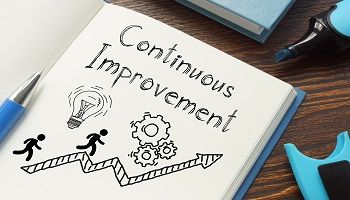Practical Perfectionism and Continuous Improvement
“One of the basic rules of the universe is that nothing is perfect. Perfection simply doesn’t exist…..Without imperfection, neither you nor I would exist” ― Stephen Hawking
“Continuous improvement is better than delayed perfection.” Mark Twain
Practical perfectionists use the urge for perfection as fuel for achieving it, accepting that while things could be better, they may never be perfect.
Practical perfectionism is at the root of quality improvement. We set standards and try to meet them with the goal of optimal performance – performing as best we can. We recognize that optimal performance is perfection even though there may be flaws, errors, and omissions.
Perfect
Sometimes things are perfect as they are:
- People are happy, effective, accepting, flexible and resilient
- Change and problems are well managed
- Communication and relationships are healthy
- Performance quality is high, and
- There is a continuous improvement process that asks “How can we do better?”
In that ideal scenario the stakeholders are aware that everything is in motion, continuously changing. They know that expecting to sustain a static perfect state is a pipe dream – an unattainable hope. They know that perfection is in the process and not the outcome. They strive for the perfect outcome even though they know it may not be attainable.
The word perfect is an adjective and verb. We perfect our process to make it perfect. According to Merriam-Webster the meaning of perfect is:
“Being entirely without fault or defect flawless. a perfect diamond. : satisfying all requirements : accurate. : corresponding to an ideal standard or abstract concept. a perfect gentleman.”
Perfectionism
Perfectionism is a character trait that can be healthy, positive, and functional or unhealthy negative, and dysfunctional. It is a need to have oneself, others, or things in general to be perfect. There is an uncomfortable felt sense, a pressure from within, when things are not perfect. There is a belief that perfection is possible and necessary.
Perfectionists set standards that they use to judge their own behavior, and the behavior of others. They assume that others expect them to meet those self-set standards.
When perfectionism operates unconsciously it gets in the way of optimal performance. For example, it can manifest as procrastination because things are not perfectly ready. “I can’t get started until I am absolutely sure that I won’t be interrupted.” Some perfectionists procrastinate or avoid acting because they fear that their work will not be perfect.
Perfectionism may emerge as a negative self-image or image of others because they are not perfect.
For example, a project sponsor keeps putting off the funding of a project because the design team cannot find the perfect solution or the selection of a key product or system is held up because there are no perfect options.
The expectation that a team’s or individual’s performance be perfect can motivate high performance or, if the expectations are impossible to meet, over-stress and demotivate.
Advertisement
[widget id=”custom_html-68″]
Striving and Concerns
Perfectionists strive to achieve personal standards that they set themselves and are concerned that they won’t measure up. The striving may be focused on both themselves and others.
They worry and fear that they will be punished or rejected if they fail to be perfect in the eyes of others – their boss, client, peers, etc. They tend to promote the impression of their own perfection and work to prevent others having a negative impression.
The striving and concerns, when they are unconsciously driven, waste energy and create stress, the enemies of optimal performance.
Non-perfectionists
Non-perfectionists tend not to have pre-stated standards or expectations about themselves or others. Non-perfectionists are OK with whatever happens. While this leaves them with less stress and may even be a sign of enlightenment, it does not promote continuous performance improvement.
Acceptance is a positive trait, but it can also lead to stagnation and the degradation of performance. Healthy acceptance accepts things are as they are in the moment, that they will change, and that with effort they can be made better into the future.
Practical Perfectionists
Practical perfectionism involves setting rational performance standards and expectations and generating the motivation to achieve them. It is an example of how we can use a character trait to its best advantage.
It begins with the acknowledgement that perfectionism is at work. This is an aspect of self-awareness, the sense of what is happening internally and how it is influencing behavior.
With that awareness, perfectionism can be used as a powerful force in optimizing performance and promoting personal growth, emotional intelligence, and wellness. Perfectionism is accepted and managed.
Practical perfectionists have ambitious standards and bring rational thinking to bear. They assess why they think their standards and expectations are realistic. They look at the costs and benefits of improvement and decide whether to improve radically or incrementally, or to leave well enough alone, making the best of the situation.
Perfectionism is a positive trait if it is moderated by acceptance of things as they are, self-awareness, rational thinking, and realistic understanding of
- what ‘perfect’ means,
- whether and how it can be achieved,
- how much it costs,
- how long it takes to achieve it, and
- whether achieving it is worth the time and effort.
Practical perfectionism drives continuous improvement and optimal performance.
Overcoming Obstacles to Perfect Performance
It is hard to imagine why anyone would not embrace a practical perfectionist mindset. But the reality is that there is resistance to self-awareness and rational thinking.
Overcoming obstacles to applying practical perfectionism to continuous improvement begins with self-awareness and understanding among team members and leadership at all levels..
When individuals realize that they are being overly stressed by their own perfectionism or are overly stressing others by expecting the impossible, they can act to change.
In projects the change comes about when perfectionist managers or clients realize that their expectations are irrational and counterproductive. Then the process of defining goals, acceptance standards, value, costs, risks, and benefits will lead to expectations that can be met.
Practical perfectionism combines emotional intelligence and analytical process thinking to promote a perfect process.




